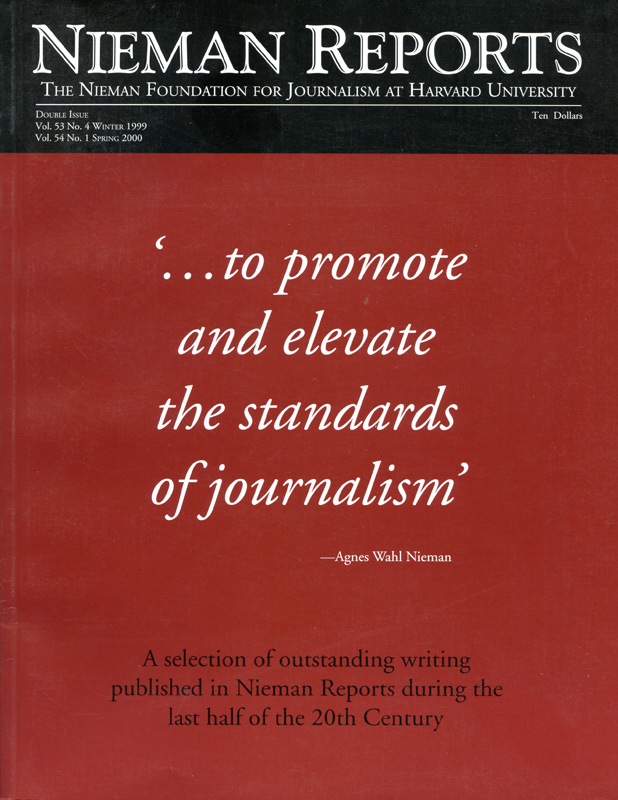Nothing about journalism so engages—and enrages—the public and practitioners as do discussions about whether reporters can be and are objective observers of events they describe. Innumerable studies have set out to chart bias and gather evidence to support or debunk a perceived assumption about leanings one way or another. Yet when the concept of journalistic objectivity came into being in the early 20th Century, it did not imply that journalists are free of bias. Instead, the term was applied to the method journalists use to test information and provide their audiences with a transparent look at evidence they gathered. This method of reporting was developed precisely so that personal and cultural biases would not undermine the accuracy of their work.
Discussions about objectivity have frequently occurred in the pages of Nieman Reports. John L. Hulteng (NF’50) wrote during his Nieman Fellowship about his concern that reporters, by interpreting events rather than strictly reporting them, were crossing the line into what he believed was the purview of editorial writers. “If we make it official policy to spice our whole news report with gobbets of opinion in the guise of background facts, we can’t expect reader trust to hold up,” he cautioned.
By 1952, David Manning White was worrying aloud about how public figures such as Senator Joseph McCarthy were relying on “objective” reporting—typically reporting that included charges and countercharges without the imposition of journalistic judgment—to put forth accusations. And in 1955, Wallace Carroll labeled “objectivity” as “Deadly Virtue No. 1.” “Too often our objectivity is simply the objectivity of half-truth,” Carroll wrote.
Wes Gallagher observed in 1968 that “to the true newsman partisanship is the original sin, the apple in the journalistic Eden.” And Eric Sevareid in 1970 noted that “Militant young men and women” journalists were arguing that “even the quest for objectivity is a myth, that the prime purpose of the press is not to report the world but to reform it, and in the direction of their ideas.” Sevareid argued strenuously against this: “They believe this will give a true integrity to news columns and news broadcasts. I believe it will ruin them.”
A heated dialogue among white newsmen and black grassroots advocates in 1971 about how news events involving minority groups are portrayed pointed out how difficult it is to figure out what objective reporting might look like when perspectives on the same event diverge.
By the mid-1990’s, when the civic journalism movement was emerging, Lou Ureneck (NF’95) explained how and why the Portland (Maine) Press Herald employed a new technique in which reporters included their independent conclusions as a part of the story. At the decade’s end, journalists at the second Watchdog Journalism Conference were ruminating on whether there is any such thing as a truly “independent source” and what role reporters’ judgment plays in covering news.
Discussions about objectivity have frequently occurred in the pages of Nieman Reports. John L. Hulteng (NF’50) wrote during his Nieman Fellowship about his concern that reporters, by interpreting events rather than strictly reporting them, were crossing the line into what he believed was the purview of editorial writers. “If we make it official policy to spice our whole news report with gobbets of opinion in the guise of background facts, we can’t expect reader trust to hold up,” he cautioned.
By 1952, David Manning White was worrying aloud about how public figures such as Senator Joseph McCarthy were relying on “objective” reporting—typically reporting that included charges and countercharges without the imposition of journalistic judgment—to put forth accusations. And in 1955, Wallace Carroll labeled “objectivity” as “Deadly Virtue No. 1.” “Too often our objectivity is simply the objectivity of half-truth,” Carroll wrote.
Wes Gallagher observed in 1968 that “to the true newsman partisanship is the original sin, the apple in the journalistic Eden.” And Eric Sevareid in 1970 noted that “Militant young men and women” journalists were arguing that “even the quest for objectivity is a myth, that the prime purpose of the press is not to report the world but to reform it, and in the direction of their ideas.” Sevareid argued strenuously against this: “They believe this will give a true integrity to news columns and news broadcasts. I believe it will ruin them.”
A heated dialogue among white newsmen and black grassroots advocates in 1971 about how news events involving minority groups are portrayed pointed out how difficult it is to figure out what objective reporting might look like when perspectives on the same event diverge.
By the mid-1990’s, when the civic journalism movement was emerging, Lou Ureneck (NF’95) explained how and why the Portland (Maine) Press Herald employed a new technique in which reporters included their independent conclusions as a part of the story. At the decade’s end, journalists at the second Watchdog Journalism Conference were ruminating on whether there is any such thing as a truly “independent source” and what role reporters’ judgment plays in covering news.



